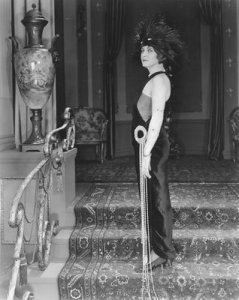A Woman of Paris

”I don’t mind coincidence [in a storyline] -- life is coincidence -- but I hate convenience.” – Charles Chaplin, to A Woman in Paris assistant director Eddie Sutherland
”Why do all comedians turn out to be sentimental bores?” – A cynical movie-goer to Woody Allen, in Stardust Memories
Watching A Woman in Paris, you just know you can read right into the minds of Chaplin’s fellow movie-makers and executives at United Artists in 1923: “We waited four years for you to get out of your other contract and give us a movie for UA. And this is it? A melodrama in which you don’t star, about a bunch of rich people in Paris who nobody can relate to?”
And make no mistake: For all of Chaplin’s ideals about subtle acting, this is an all-stops-out melodrama – a nicely-acted one, but still a melodrama. (If you still have any doubts, listen to the musical score Chaplin provided for the movie in 1970, and pay attention to the shrieking notes in the opening scenes with the fiancée and his mother.)
That’s not to say that the movie doesn’t have its moments. In fact, if you can make it to the ending, Lydia Knott (as the mother) provides a subtly satisfying performance. And unlike Woody Allen in a similar mood (when he followed his Oscar-winning comedy Annie Hall by providing United Artists with the laugh-free dirge Interiors 55 years after Chaplin’s mood-swing), A Woman in Paris has some subtle humor to it. But you have to sit through an awful lot of guff to get to the good stuff.
Chaplin intended the movie as a hopeful career-maker for his long-time supporting actress Edna Purviance. She plays Marie St. Clair, a young woman in love with momma’s-boy Jean (Carl Miller), who wants desperately to marry her. For reasons richly unexplained, Marie is despised by both Jean’s father and her own stepfather. (The ostensible plotline is that the two sets of parents oppose the marriage, Romeo and Juliet-style. Yet the credits make a point of identifying that opposing character as Marie’s stepfather. Is Chaplin hinting at some sordid relationship between stepfather and stepdaughter that couldn’t be blatantly spelled out in 1923?)
In any case, Marie is to purchase train tickets to Paris, after which Jean will meet her at the train station and they will elope to Paris to marry. But just as Jean is preparing to leave his home for good, his father dies of an apparent heart attack. Marie phones Jean, who vaguely tells her that something big has come up and he cannot meet her at the station. Conveniently, Jean is temporarily called away from the phone, and Marie is too furious to wait around and find out what has kept Jean from meeting with her. So it appears we have the 1923 version of what film critic Roger Ebert calls “The Idiot Plot,” in which the story could be resolved in two minutes if it weren’t for some implausible glitch tossed into the script.
Next thing we know, Marie is a fancy “kept woman” in Paris. Okay, where did that one come from? Maybe that smug stepfather was onto something. Anyway, Marie is the mistress of a most unapologetic man-about-town, Pierre (Adolphe Menjou, in a performance that did make his career, and rightly so). Marie eventually but platonically reunites with Jean (more plot “convenience”), and most of the movie involves Marie’s moral battle between banal true love and wallowing in all the dough in which Pierre keeps her.
One of the movie’s most famous moments is also its most telling about Marie. At one point, Pierre needles Marie about how she loves the lifestyle to which he has accustomed her, and to prove his point, Pierre fondles the pearl necklace that Marie is wearing. In a fit, Marie tears the necklace off and throws it out the window. A few moments pass. Marie happens to look out the window and sees a street bum making off with the necklace. Marie gets so frantic about losing her symbol of wealth, she rushes out of her apartment and grabs the necklace back from the tramp, as Pierre witnesses the whole thing and rightly laughs his head off. It’s pretty hard to take Marie’s battling conscience very seriously after that.
There really are a lot of lovely moments in the movie, cinematically and story-wise. But Chaplin is so eager to impress us with his characters’ upper-class lifestyle that it’s often a struggle to stick with the story. (When a character in a restaurant orders champagne truffles, Chaplin even goes so far as to provide an intertitle explaining the origin and use of champagne truffles – for the benefit, one can only guess, of all his Spam-eating fans.)
It’s rather ironic that Chaplin felt he had to go all the way to Paris to provide such a tone-y scenario, since this battle of class-vs.-crass feels very dated in the age of “Desperate Housewives.” Happily, Chaplin got this class struggle out of his system and returned to form (most would say well beyond form) with his next film.
Click here to return to:
HomepageFilmography